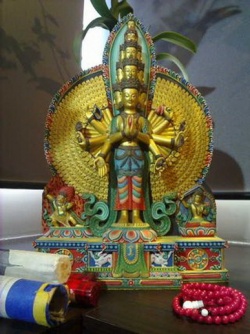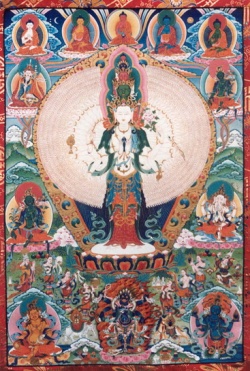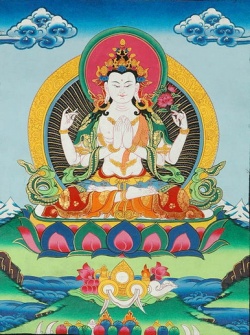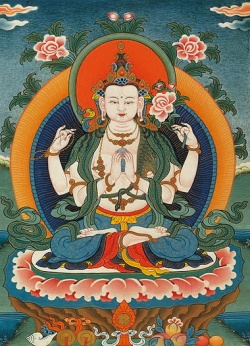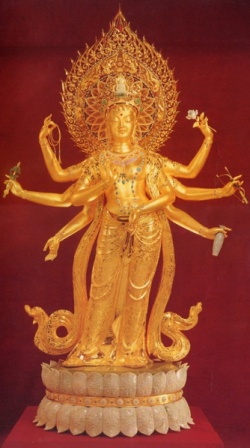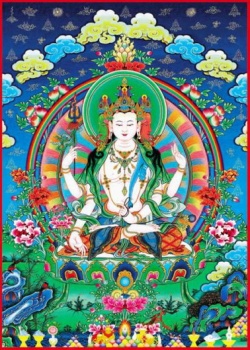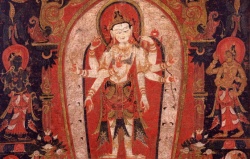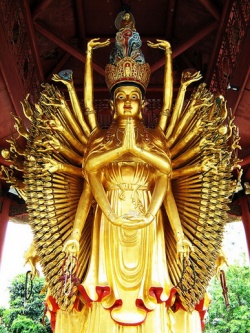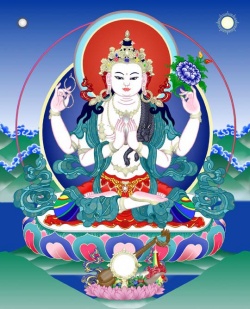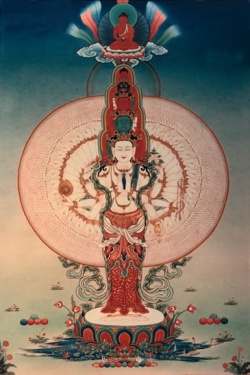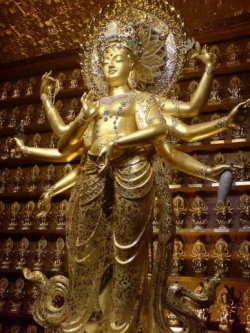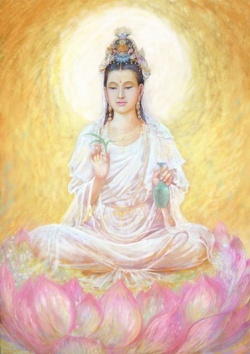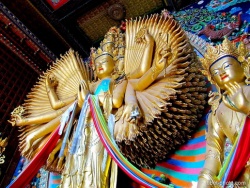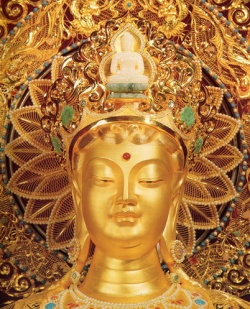The Creation Of Goddess Of Mercy From Avalokitesvara
by BAGYALAKSHMI
Bodhisattva Avalokitesvara/Guanyin occupies a unique place in the Mahayana Buddhist pantheon. Buddhist sutras speak of several bodhisattvas but it is Avalokitesvara/Guanyin who is revered and adored by followers of both Hinayana and Mahayana Buddhism and by all art lovers. He/she has acquired a status equal to the Buddha and sometimes his importance surpasses even the Buddha's. The Westerners know the deity as the Chinese goddess of love and compassion.
If Buddhism has been the greatest contribution of India to world religions, the transformation of Indian Avalokitesvara to Guanyin-the Goddess of Mercy -is the creation and contribution of China to the Buddhist world. Despite three major setbacks suffered by Buddhism in Chinese history, the symbol of Guanyin, the goddess of mercy however had continued to prosper and flourish and has rightly been called the "cult of half Asia".1
In the Mani Kambum it is related that Bodhisattva Avalokitesvara emerged as a ray of white light from the right eye of Amitabha after the latter had given himself up to earnest meditation and hence regarded as his spiritual son. The Bodhisattva brought forth the prayer "Om mani padme hum", "Oh! the jewel (of creation) is in the Lotus!"
The Avalokitesvara/Guanyin formulation has not been free from controversy, almost from the inception. The Chinese word "Guanyin" is an abbreviation of "Guanshiyin" which denotes "seeing the voice of the world" if rendered literally. Is this meant to be a translation of Avalokita, Avalokita svara or Avalokitesvara?
The name Avalokita means "viewed", "beheld" and can be used in the masculine, feminine and neuter genders. Avalokita-svara means the hearer of voices of the suffering beings while Avalokitesvara conveys the existence of a Lord who is omniscient in observing all the activities, including sufferings of humanity. Such a deity can be called as the lord who looks in every direction or "Regarder of cries of the suffering beings". Kumarajiva's and Xuanzang's translations as Guanshiyin, Guanzizai continued for some time but it was the term Guanyin which found favour ultimately.
Though many Sutras have spoken the greatness of the Bodhisattva. it is in the Saddharma pundarika sutra (Miaofa lianhuajing) -- jewel among the Mahayana Sutras --where Avalokitesvara's virtues have been extolled in a special chapter. The chapter itself became so important that it was treated as a separate sutra called the Avalokitesvara sutra. The importance of the Avalokitesvara Sutra came to be known when a King fell ill and he was asked to recite this particular Sutra. The King was cured and thus faith in the Sutra was generated and the Bodhisattva too gradually came to occupy the central stage.
The popularity of Avalokitesvara is due to the personification of karuna (compassion) and prajna (wisdom). While wisdom makes the Bodhisattva close to the human minds, compassion makes him/her close to the human hearts. All other deities possess these two qualities to a certain degree, but for Avalokitesvara/Guanyin, being their perfect representation, it is easier for him/her to assimilate the attributes of other Brahmanical deities like Brahma, Vishnu and Siva thus becoming the most powerful of all spiritual powers, the father and mother of all.
Avalokitesvara who is a male Bodhisattva in India was transformed into a goddess in a Chinese male oriented society. A preliminary statement can be made here, that sinicization of Buddhism led to the creation of the Goddess of mercy with Chinese characteristics from a male deity with Indian characteristics. What brought about this change in the gender of this Bodhisattva and why?
This transformation of a male deity from India into a female Goddess of mercy in a strongly patriarchal Chinese society both at the terrestrial and celestial levels has surprised many. Celestial because for any woman to gain entrance into the Paradise of Amitabha, she should shed her female form and assume a male form.
For a female divinity to have grown in the terrestrial level in a male dominated society, and to have given rise to a cult is equally strange. It is not that there were no goddesses prior to the introduction of Buddhism in China. Only they were not as important.
The transformation does not appear to have come about suddenly. The male Bodhisattva was gradually given an ambiguous form so that people saw what they desired to see. If we examine the iconographic representations of the goddess in China and elsewhere, the paintings and statues of this Bodhisattva initially did not reveal this change. The female anatomy was conspicuously absent, but from a graceful body structure one could feel the feminine element. At the same time the male characteristics of moustache and beard were also visible in the form of tendril like lines. Even these vanished in the sculptures of the Dazu caves where they appear to be completely female.
Dreams, Visions and Legends of Guanyin
Dreams, visions, naturally formed images, efficacy, configuration of multiple images, pilgrim sites, legends, miracles, configuration of multiple images, folklore and last but not least, the reign of Empress Wu Zetian of Tang Dynasty, appear to be the factors which contributed to the creation of the Goddess of Mercy. Although they seem to be exclusive of each other they are in fact interlinked, making it a process of "cause and effect" for the evolution of the goddess.
The "creation of Goddess of mercy" symbolic of maternal love and infinite compassion can be traced to the 5th century and not as late as 11th or 12th centuries as made out by many scholars. The encyclopedic Fayuan zhulin which was compiled in 668 mentions that Guanyin manifested himself in feminine form in AD 479 to rescue his devotee Peng Zujiao from chains. There was another instance when that Bodhisattva had manifested himself in the female form to heal the "dissolute and emaciated Northern Qi emperor Wen Cheng (reigning 561-65 AD). With the translation of the Cundi devi dharani sutra in the seventh century, the feminine aspect of Guanyin in the form of Cundi-Avalokitesvara (chun tie-guanyin), "mother of seven kotis of Buddhas" was established in China.
In the annals of Tianzhu, Guanyin is said to appear in the form of a woman in white in the dream of Qian Liu (852- 932 AD), the founder of the Wu Vue kingdom, and told him that his kingdom would survive the chaotic Five Dynasties period for he was compassionate and averse to killing. She also told him that he could find her on Mount Tianzhu in Hangzhou. Later, when he became the king he dreamt of the same lady who asked him for a place to stay and promised to be the tutelary deity of his kingdom. Upon inquiries the king found out that the only white robed Guanyin image was in the Tianzhu Monastery and the image housed in the Monastery was that of the feminine white-robed Guanyin.
In the year AD 939, it was said that while meditating, monk Daoyi saw a bright light coming from the stream. When he looked up he found a wooden piece with a strange fragrance. He gave the wood to a local artisan for making an image of Guanyin. The artisan cut open the wood and found a ready-made "naturally formed image" of the deity. The bodhisattva's face was compassionate and beautiful. The artisan planned to keep this image and make one from ordinary wood.
But Guanyin appeared in the dream of Daoyi and warned him of the deception. The artisan had to part with the ready-made image. Some years later Daoyi had another dream in which a "white-robed person" told of the arrival of a monk from Luoyang the following day and that he, Daoyi should ask him for the relic of the Buddha that was amongst the latter's possessions. The next day the monk came and Daoyi asked for, the relic. The monk saw the image and was greatly moved and offered the relic1o be installed in its crown. Guanyin himself is said to have appeared as a white-robed person in Daoyi's dream and predicted about the monk's visit.2
Visions of Guanyin as a beautiful lady to vision-seeking pilgrims added another dimension to the popularity of the goddess. The Chaoyin dong (Cave of Tidal Sound) in Mount Putuo is the foremost place where the pilgrims had visions of the Bodhisattva. With the passage of time places like the Diamond Boulder and the Purple Bamboo Grove were also regarded as Guanyin's preaching sites. The Fozu Tongji has the following passage from the Cao-an lu (Record of a grass hut) written by Nanhu Daoyin during the period 1165-73 AD:
"Mount pu-to is in the great ocean. It is situated southeast of [[Jin [Ning-po]], about a thousand kilometres by the water route. It is no other than the mountain called Potalaka that is declared by the Hua yen Jing to be the 'isolated place at the end of the ocean' where kuanyin Bodhisattva lives. It is also no other than the Mount Potalaka that is declared by the Dabei Jing to be the place where the palace of Kuanyin in which Sakyamuni Buddha reveals the heart-seal of the Mantra of Great Compassion is located. The Cave of Tidal Sound is on the island. Ocean tides pound in and rush out day and night making deafening noises.
In front of the cave is a stone bridge on which pilgrims stand facing the cave to pray. If they are sincere, they sometimes can see the Great Being sitting leisurely. Or they will see Sudhana come forward as if to welcome them. Other times one will see the pure vase of green jade or the Kalavinka bird flying as if performing a dance. Some six or seven li from the cave there is a large monastery. Merchants, diplomats and tribute bearers sailing to and from the various countries in the Eastern Sea would come here to pray for safety. Those who are reverential and sincere all receive protection without fail."
It was the Cave of Tidal Sound where Guanyin appeared to pilgrims as mentioned in the early accounts of the island. From the Song dynasty onwards, important officials and well known persons who visited the islands wrote about it. A collection of poems and essays left by the visitors are collected in the island gazetteers. Besides important people, ordinary pilgrims and even illiterate ones have also helped by word of mouth repeating stories they had heard or marvels they had themselves witnessed.
Stories were of great help in making Guanyin a goddess. Emperor Wenzong of Tang (AD 827-39) loved to eat clams. Fishermen on the southeast sea coast were burdened with the task of supplying clams to the emperor. One day a huge clam was served that could not be opened by a knife. When the emperor knocked on the shell the clam opened by itself and inside was a portrait of Guanyin. The emperor was astonished and preserved the shell in a sandalwood box. He consulted a Chan master who explained to him that the appearance was to kindle his faith so that he would be judicious and love the people.
The Lotus Sutra says that for those who need to be saved by the Bodhisattva, Guanyin appeared as a Bodhisattva to preach the dharma. The emperor said that he had seen the form but had not heard the preaching. The Chan master asked the emperor if he believed what he saw and the latter replied in the affirmative. The master said that if there was faith then the emperor had already heard the preaching. From that day onwards the emperor stopped eating clams and ordered the installation of Guanyin images in the monasteries of the country.
Guanyin with the fish basket is based upon the legend of a Chan believer and his daughter Lingzhao who was believed to be a manifestation of Avalokitesvara carrying a bamboo basket. The story goes thus -In the year AD 817 of the Tang dynasty a beautiful girl in the countryside was much sought after for marriage by eligible young men.
As the number of men who were eager to marry her was large, she adopted a novel method for selecting a suitor. She put forth a condition that she would marry the person who would memorize the Guanyin chapter of the Lotus Sutra in one night. Twenty men succeeded in doing this but because there were still too many for the marriage, she again made a request that these twenty should learn by heart the Vajracchedika sutra overnight. Once again there was a sizable number of men who had achieved the feat.
The girl's third condition was that he who memorized the entire Lotus Sutra in just three days could marry her. A man named Ma Lang was the only one who could accomplish this and so the marriage was to take place.
Just as the marriage ceremony was to commence the girl took ill and died. Soon after the burial an old priest visited Ma Lang and requested him to dig up the grave. The coffin contained only pieces of golden bones. The old priest said that the girl was a manifestation of Guanyin who had come to lead people to salvation. After saying this the old man too vanished. From then on the people of the district became Guanyin devotees.
The Legend of Miaoshan3
Over the years, the story of a girl (actually Guanyin) who successfully resisted her father's attempt to get her married, sought her own destiny while bringing succour to the suffering people grew into a legend. Many variations of this story have also been extant from time to time as the Chinese reincarnation of Guanyin. The most popular text however is the one written by the Buddhist monk Puming of the Tianzhusi after a vision he experienced in 1103. The version given by Vu Chengxue can be summarised as follows:
"Guanyin was born with the name of Miaoshan, the youngest daughter of King Miaozhuang. From her childhood, she followed the precepts of religion. When she came of a marriageable age, the King sought a husband for her. Guanyin defied her father. Persuasions and threats from the king had no effect on the girl's resolution not to marry. In anger, the King sent her away to the White Sparrow Monastery with instructions that she should be compelled to obey. The nuns tried their best and ill treated the girl to make her submit.
This only strengthened her resolve. Since the nuns failed, the King set fire to the monastery. While all the nuns died, only the girl who sat erect reciting sutras survived. The King sent for his daughter in the hope that she would change her mind. But finding her resolute, the king ordered her execution. As she was about to be beheaded, the sword broke into two and a tiger from nowhere bore her away to a forest. She remained unconscious for sometime and then dreamed that two boys in black carried her to the Underworld. Here she met yama who attended her with great respect. She saw all the sinners and other suffering beings. She recited sutras on their behalf and they were delivered.
When she awoke evil beasts and venomous dragons were struggling to harm her. But when she took refuge in a hermitage an old man gave her mountain peaches to eat and led her to Xiangshan where she made her dwelling. She pursued religious cultivation for some years. One day from afar she saw that the King was sick, not responding to treatment. She took the form of an aged monk and told the King that he could be cured only by the arms and eyes of his closest kin. The King asked the monk for advice once more and the monk said the "holy elder" on Xiangshan would grant him his wishes. The holy elder, who was none other than Miaoshan severed her own two arms and her two eyes and handed them over to the envoys.
The King was advised to meet the holy elder. When the king met the holy elder, she was indeed without arms or eyes and the body was covered with streams of blood. The King was grieved and was also startled to find that the elder resembled Guanyin -and was his third daughter. The King besought heaven and earth to make his daughter whole again. Soon, the holy elder had arms and eyes by the thousand. And then Miaoshan bowed before him and urged him to practise good deeds to which the King readily agreed."
The story of Miaoshan in various forms had found an immense appeal and had a wide circulation. This legend no doubt offered women in China a role model to defy parental marriage arrangements while observing the path of piety.
At another level, the legend of Miaoshan had many important lessons for the women. First is the filial piety which Miaoshan exhibited. Instead of resenting the wicked persecutor, she returned to her father when he was seriously ill. There is an element of sacrifice in giving up her arms and eyes. And above all, it had a great appeal to women as it symbolized the independent female spirit and the willingness to suffer in the face of pressures from the family.
Configuration of Images Into Female Guanyln
Although Chinese mythology had been dominated by male gods and masters, the presence of female divinities has always been a part of Chinese folk belief. Amongst them can be recognized four divinities whose collective popularity extends from ancient times to the present. They are Nuwa, the legendary creatress of humans, Xiwangmu the Queen Mother of the west, Guanyin the Goddess of Mercy and Tianhou the Empress of Heaven. These four divinities have an interesting and significant relationship and collectively they represent a continuing "spiritual potency" and significance to the masses, religious and political groups.
Nuwa was most revered as the mother goddess. She created the first human beings, the nobles from yellow soil and base men from straw. She battled against floods and destroyed monsters. Nuwa not only created beings but also constantly changed shape, an attribute associated with Guanyin too.
Xiwangmu is represented as a beautiful lady attended by the "Daughters of Jade". It is to be noted that in the early versions of the legend both Nuwa and Xiwangmu looked rather alien to the natives of China but by and by were totally integrated into the superstructure of ruling hierarchy and rationalized in the popular belief of the oral literature. But the Buddhist divinity Guanyin which was foreign in origin appeared to have overtaken both these feminine divinities as well as Tianhou.
Forgiveness, mercy and compassion in the Chinese context were seen as primarily feminine characteristics. During the Tang Dynasty Guanyin has been portrayed as a Goddess and a companion to Amitabha, Lord of the Western Paradise. This led to Guanyin's association with the Western Paradise and thence to the sharing of the characteristics with the Taoist Queen Mother of the west -Xiwangmu. Later the characteristics of goddess Tianhou were also absorbed by Guanyin and the latter was looked upon as a goddess of sailors and a protectress of those at sea.
Top of the Page
Shuiyue Guanyin (Guanyin of Moon and Water)
The concept of the Shuiyue Guanyin arose from the eminent Tang poet Bai Juyi's poem "Ode to the portrait of Shuiyue Guanyin" expressing his devotion for the "Moon's reflection in Water form of Guanyin" (Shuiyue Guanyin). The poem reads as follows:
"Floating in water,
Clean and pure,
As if hiding
In the white light.
When I set my sight
All egos are vanishing.
Your disciple Bai Juyi
With devotion under your feet.
You are my cynosure
Life after life forever."
The poem was represented in a painting by the famous Tang artist Zhou Fang. Although it is one of the thirty three forms of Guanyin, it is not based on the scriptures. The Dunhuang manuscript P. 2055 mentions that Zhai Fengda copied the Sutra for the Shuiyue Guanyin as a mark of wishing good luck to his late wife. But unfortunately the original is no longer to be found. There is no documented base for the Sutra in Buddhist Scriptures and it is difficult to ascertain whether this sutra was from India or the creation of the natives. It was after about a century that the artists of Dunhuang took a fancy to the concept of the Shuiyue Guanyin.
Songzi Guanyin
Songzi Guanyin (Guanyin who gifts sons to mothers) is another form of Guanyin and regarded to be a Chinese creation -at least adaptation. The Lotus Sutra states that a woman desirous of a male child should only pray to Avalokitesvara and her wish is granted. The concept of Songzi Guanyin may have its origin in the Indian goddess Hariti. Hariti, a Hindu goddess was said to be originally an ogress. The legend, according to Samyuktavastu, said that once Hariti decided to capture and eat up all the children in Rajagriha. All the children disappeared and there were bitter lamentations.
The bereaved parents went to the Buddha and requested him to make Hariti harmless. Buddha remained silent but the next morning after his round with the begging bowl asking for alms he went to Hariti's abode and finding the five hundredth and the youngest son Priyankara there. He hid him inside his begging bowl. On her return Hariti found that her favourite son was missing and asked the remaining 499 sons for the whereabouts of the youngest one.
They had no knowledge of the Buddha's act. In great despair Hariti started hunting for him till her search brought her to the Buddha where after paying her respects to the Buddha she asked about her son. The Buddha replied that she must first promise to follow his precepts and give the people of Rajagriha assurance of security to which she readily agreed. The Buddha then converted her, and she in turn became the "Protectress of Children".
At a conceptual level "child giving" was not restricted to Guanyin alone but was a function of earlier goddesses also. But the very same role seems to have been appropriated by Guanyin subsequently. In another instance Songzi Guanyin is said to be associated with Yaoji, the Taoist goddess, daughter of Xiwangmu. In this form the "Princess of Fairy Clouds watches over women in their confinement and cares for them during their childbirth."
Alice Getty has cited the case of "Songzi Guanyin" who was looked upon as "Dispenser of Fecundity" and for whom there was an extant cult of those desiring children.4 She agrees that Songzi Guanyin was the female form of Avalokitesvara with a child in the arms as a symbol of the quality of "Giver of Children". The transition to the female form with its flowing robes was therefore a "natural convergence".
The conclusion that could be drawn is that in Chinese society even an "imported deity" like Guanyin was subjected to "profound transformation" expressive of the underlying need for mythical feminine symbols in the context of dominant hierarchy. The local folk traditions seem to have accepted the female transformation consistent with the traditions of local goddesses. Guanyin seems to have absorbed all the local beliefs and traditions in a big way.
Can it be said that Guanyin became more popular in China as her all pervasive qualities offered solution to the problems faced by women in China particularly in a sociological order fixed by Confucian ideals and carried on for centuries? There appears to be some force in this argument. Barbara Reed in her study has said that in popular Chinese beliefs, the blood of both menstruation and child birth is spiritually polluting.5 Guanyin responds to women because of their sex and is said to possess power to save women from sexual attacks, physical, emotional and social suffering.6
The thirty three manifestations of Avalokitesvara/Guanyin in the Saddharmapundarika became popular cults in Sui (581- 617) and Tang (618-907) dynasties. These manifestations according to Prof. Lokesh Chandra indicate the assimilation of Indian and indigenous deities and beliefs and is a continuing process.7 "The incorporation of Buddhist goddesses into Guanyin and the natural propensity of women towards feminine forms, not to speak of several other factors led to Guanyin in female form becoming dominant in China especially after the Tang and more often the Song Dynasty".
The Dunhuang murals bear witness to the trend of painters making the images of Bodhisattvas more feminine and worldly in order to "please the viewers". The thirty three manifestations of Guanyin kindled the imagination of painters resulting in a plethora of Guanyin images. Besides the painters, perhaps the whims and fancies of the common people also played an important role in depicting Guanyin as a goddess.
Very many legends interwoven with local folklore on the miraculous powers of Guanyin are extant in China. The iconographic models of Guanyin seen in various manifestations all over China and in places where overseas Chinese are in large numbers is a testimony to its popularity and the faith the people have in the powers of Guanyin.
Certain generalized observations can be made from the depiction of Avalokitesvara / Guanyin and the ideas and concepts that were sought to be conveyed by the extant images. These include:-
Avalokitesvara in the desire to help humankind assumed different forms and it is no surprise that Avalokitesvara / Guanyin symbolizing divine womanhood was considered to be most appropriate.
Compassion and mercy were considered as special attributes of women.
If we are to be guided by the early Mahayana texts, it does not matter whether god is depicted in male or female form or in an asexual form, as the ultimate reality is in nothingness "Sunyata".
The depiction symbolized and popularised certain myths and legends associated with Guanyin. Helping the sea farers, "giving children", Guanyin with a fish basket8 identified the deity with the common people who yearned for children.
Guanyin in the course of Chinese history absorbed the magical powers and attributes of existing indigenous divinities and such a changeover took place without any tension in the then prevailing social or religious order.
The transformation of Guanyin into a female form should be seen in the overall context of Sinicization. Such transformations were not restricted to Guanyin alone. Maitreya was transformed into a totally new form of a "laughing Buddha", a practice still prevalent in China and Southeast Asia. Such transformations have evolved, perhaps to fit in certain prevailing ideals then dear to the Chinese, like having an offspring, prosperity etc.
The French Sinologist Maspero has suggested an explanation for the transformation of Avalokitesvara into a female form. Mahayana Buddhism had always considered enlightenment as the conjunction of wisdom and compassion. Symbolically, in Tantric Buddhism, wisdom is considered to be male and compassion female. With the introduction of Tantric Buddhism in 8th century made popular by many Tantric masters who were active at that time, all the Buddhas and Bodhisattvas were provided with female consorts.
The evolution of Guanyin as the goddess of mercy has been explained by John Blofeld as related to Tara. Tara is looked upon as "a beautiful female divinity able to manifest herself in twenty-one different forms for the sake of succouring sentient beings." Tara has two main functions: to rescue human beings from woes, to assist them in ridding themselves of the delusions binding them. Blofeld believes that these are the same functions of Guanyin also.
According to him such an attractive being supported by Buddhist texts would not have been overlooked by the Chinese unless they had some other means of portraying compassion. The Chinese have always been disposed to envisage friendly divinities in idealized human form, and the beautiful Tara now as a sweet faced matron, now as a winsome maiden would have been very appealing.
As Guanyin the Bodhisattva of compassion could not be ignored, the mediator and the artists would have hit upon the idea of visualizing Guanyin in a form similar to Tara's and he cites three early paintings where the posture and mudras were akin to Tara's. These images belong to an era "where the forms of Tara and Guanyin began to merge".
In his book "Hinduism and Buddhism" Sir Charles Eliot states that the creation of female Guanyin was probably "facilitated by the worship of Tara and Hariti, the fatter is frequently represented as caressing a child." In his view the Chinese religious sentiment required a Madonna and it is not unnatural if the god of mercy who is reputed to assume many shapes and to give sons to the childless came to be thought of chiefly in a feminine form.
The Wu Interregnum
An aspect that needs to be examined is the Chinese history during the Sui times. Yang Jian the founder of the Sui Dynasty, and who ruled as Emperor Wen was born in 541 in a Buddhist temple. Until the age of 12 he was brought up by a Buddhist nun whom he fondly called as the preceptor (A-che-Ii, Acharya in Sanskrit).
Emperor Wen's queen Wen Xian came from a devout Buddhist family and was herself an ardent Buddhist who used to arrange Sutra reading in the palace in the evenings. Emperor Wen and his queen earned the name of ersheng --Twin-Sages. In the year 602 the empress died. The empress had been a strong influence on the emperor. On her death the court historian promptly declared her a Bodhisattva. In view of the strong influence of the empress on the administration and the spread of Buddhist ideology it is possible that the Bodhisattvaization of the empress could have marked the beginning of feminization of Bodhisattva.
Another remarkable example of feminine eminence a hundred years later was Empress Wu Zetian. Although according to the Confucian beliefs having a woman rule would be as unnatural as having a "hen crow like a rooster at daybreak", during the most glorious years of the Tang dynasty a woman did rule and ruled successfully. Women of this period enjoyed more freedom.
They did not bind their feet nor lead submissive lives. Being born into a rich and noble family Wu was taught to play music, write and read the Chinese classics. When she was only thirteen she was recruited to the court of Emperor Taizong. When she was just an obscure imperial lady, she was loved by the young prince who later became Emperor.
On the death of Taizong, Gaozong retrieved Wu from a nunnery back to the palace. Wu, who was twenty seven years of age worked her way into the inner circle of the Emperor and by her ruthless manipulations became the favourite concubine of Gaozong. In time she gave birth to the sons he wanted and succeeded in deposing Gaozong's wife Empress Wang: As mother of the future emperor of China she became very powerful.
Emperor Gaozong was a weak character both physically and intellectually. Wu on the other hand proved to be a genius in sorting out the knotty problems of the Tang Empire. When the emperor suffered a crippling stroke she took over the administrative duties of the court and a position equal to the emperor. Just as the Sui Emperor Wen and his wife Wen Xian were called then, Wu and Gaozong became er-sheng (twin sages). Actually, beneath the surface of this "twin-sagehood' of Gaozong's ruling machinery there was only one authority i.e. Empress Wu.
In order to challenge Confucian norms against ruling by women, Wu began to elevate the position of women. She had scholars to write biographies of famous women. She said that the ideal ruler was one who ruled like a mother does over her children. Inspite of her ruthless climb to power, her rule proved to be benign. After the death of Gaozong she became the first (and eventually the only one) female "Son of Heaven" in Chinese history. Some of the titles that she arrogated to herself were "Sacred Emperor of the Golden Cakra", " Shengmu" (Holy Mother), "Her Majesty fro~ the Phoenix Throne", etc.
During her reign Empress Wu placed Buddhism over Taoism as the state religion. She invited the most gifted scholars to China and built Buddhist temples and cave sculptures. Chinese Buddhism achieved its highest development under her reign. The Fengxian temple is the largest and most representative grotto at Longmen. It is said that after Wu Zetian was conferred with the title of empress she donated a year's worth of money ordinarily used for cosmetics 1° build this temple in order to enhance her prestige.
The seated Buddha in the centre of the temple is a huge statue and has the appearance of a kind and gentle woman. It could be because Wu had donated the money to carve this particular Buddha hence the womanish face. Similarly the concept of Shengmu (Holy Mother) was also Wu's creation. As she was keen to be deified she had many statues cast to her liking.
The impetus given by her for making innumerable images in female form resulted in the popularization of Guanyin as a goddess. As proof of this, one has to see the statues in the caves of Dazu (named after one of Empress Wu's reign eras) especially of Shengmu and several Guanyin images which have a distinctly royal bearing and feminine looks. Perhaps this was an important reason for scholars like Kenneth Chen to place the beginning of feminization of Guanyin to the Tang period.
Many scholars have sought to prove that Pandaravasini (clad in white) was the precursor to the White-robed Guanyin and have thus tried to explain the feminization of Guanyin. There is also the suggestion of transformation of Tara into the female Guanyin. But there is no evidence of Tara being transformed into female Guanyin or that Pandaravasini is actually White-robed Guanyin. Absence in intermediate figures in space and time indicative of a gradual evolution from either Tara or Pandaravasini into Guanyin the goddess in China is the strongest evidence against such a hypothesis.
An important aspect that negates the above theory is that the emergence of "White-robed Guanyin" in China was after a gap of four to five centuries after the appearance of Tara in India. If the colour white symbolised purity, Guanyin could have been shown dressed in white holding a white lotus seated or standing on a white lotus base and there was no need for sexual transformation.
The entry of Tantric Buddhism gave rise to a bewildering variety of forms of Guanyin in the beginning. All varieties of forms from strongly masculine to feminine and the ambivalent forms of Guanyin were noticed in the Buddhist pantheon of China. This indicates people's unquestioned faith in such forms and various miracles seen in many Chinese texts played a decisive part in carrying on worship of the different beautiful female forms of Guanyin. In fact such representations were codified by many legendary miracles experienced by people and more so by women who looked upon the Goddess for alleviating their sufferings and get them their wishes.
The Influence of Cult Sites
It can be said that the Guanyin cult took root in China only when Guanyin became associated with certain sites and when people began to go on pilgrimages to these places. The deity's popularity in China led to the growth of cultic centres in various places. Miracles firmly anchored the Bodhisattva to these sites resulting in a rich fare about the almighty Goddess of Mercy in oral literature.
The first centre for Guanyin was Xiangshan. The Xiangshan monastery had an image of the 1,000 armed and 1, 000 eyed Guanyin in Dabei Pagoda (Pagoda of the Great Compassionate one). It was described as being made in person by a human manifestation of Dabei.
Tianxiansi has an image of Guanyin which was also made by human manifestation of Dabei. Tianxiansi was a nunnery. In the era of 618-628, when the nuns wanted to have an image of the great Compassionate One painted on the wall they were in need of a good artist. In response to the call, a couple accompanied by a young girl arrived there and the girl who did the painting was apparently a manifestation of Guanyin.
Determining the sex of the Bodhisattva Guanyin (only in China) depends on the founding myths of pilgrimage sites. Pilgrimage sites vary in importance for two reasons. In some sites Guanyin may have appeared in person and performed miracles for common benefit. Some other sites may already have a miracle working image of Guanyin and thus become very well known to people all round. The Dabei pagoda near Xiangshan monastery belongs to the first category.
The Chronicle of the Upper Tianzhu tells us the "spontaneously found" image of Guanyin which turned out to be a discovery by monk Daoyi. From this account it appears that the image housed in Upper Tianzhu Monastery must have been the feminine white robed Guanyin. The white robed Guanyin became very popular from the 10th century onwards after Putuoshan became famous as Guanyin's abode and the iconography of white robed Guanyin began to be increasingly merged with that of Potalaka Guanyin.
Interest in the images and portraits of Guanyin and efforts to preserve and disseminate them were important mechanisms in linking Guanyin to a Goddess. Depiction of Guanyin in a like manner in different media undoubtedly helped its universal acceptance. Gazetteers have recorded tales of visions of Guanyin in Putuo shan in the female form with acolytes Longnu and Shan Cai. Shrines and pilgrimages form a hen-and-chicken chain-reactions to make the Guanyin cult an everlasting living culture in and outside China.
Conclusion
In India, Avalokitesvara was the product of assimilation of important Hindu deities, while in China the symbol absorbed all the characteristics and functions of indigenous goddesses as well as Buddhist goddesses like Tara and Hariti.
The Buddhist pantheon in China over a period of time had adopted many symbols some originally from India and later many other characteristics which are purely Chinese. The emergence of Moon and Water depiction of Guanyin is one such example which indicated absorption and assimilation. Another feature has been the introduction of yin symbols (for example - moon, water, vase) from the yin-yang polarity of Chinese thought.
The assimilation process was then complete. If the symbols were to indicate certain ideas of the artist (not necessarily of the perceiver), the icons of Avalokitesvara in India, Nepal and China including Tibet give rise to innumerable interpretations. The introduction of tantric Buddhism gave yet another dimension to the whole concept with a variety of new and esoteric divine forms.
Guanyin images have thus undergone considerable expansion in China and have exceeded the boundaries of Buddhism. The deity was no longer an exclusive Buddhist religious symbol but had become a popular cultural hero/heroine to both Buddhists and non-Buddhists. Buddhist influence spread to other non-Buddhist realms in the daily life and culture of the Chinese though the period cannot be specified. Therefore the multiple images of Guanyin should be seen as the multireligious and cross-cultural symbol which was definitely feminine with many additional attributes.
The mighty support given by Empress Wu to Buddhism helped the Empress to promote herself as a compassionate Bodhisattva. It could be safely said that the female form gained momentum during her time underwent a long process of transformation gradually and steadily that Guanyin came to be accepted universally as a goddess. Many legends and folklore helped in popularising the goddess. The story of Daoyi's discovery of a piece of fragrant wood floating in the water near South Wutai mountain led to the first occurrence of Baiyi Guanyin while the Upper Tianzhu Monastery in Hangzhou undergoing a major revival. The Baiyi Guanyin enjoyed widespread I popularity from the tenth century onwards. Paintings and statues, tales and myths of Guanyin temples from Northern Song (960-1127) were proof of the importance of the Baiyi Guanyin and the emergence of Putuo Shan as a famous Guanyin site.
Through multi-cultural engineering, the East Asians ultimately settled for an Avalokitesvara in the form of Guanyin, a graceful and powerful feminine symbol to demonstrate most effectively the quintessence of the Bodhisattva -Absolute Compassion. 9
Top of the Page
1. C.N. ray, "Kuan-yin, the cult of half Asia"., History of World Religions, Vol. 16, No.2.
2. Susan Naquin and Chun-fang Vu (ed), Pilgrims and Sacred Sites in China. University of California Press, 1992.
3. Glen Dudbridge, The Legend of Miao-shan, Oxford University Publishers, 1978.
4. Alice Getty, The Gods of northern Buddhism, Dover Publications, 1988.
5. Barbara Reed, "The Gender Symbolism of Kuan-yin Bodhisattva," in Buddhism, Sexuality and Gender, Sri Satguru Publications, Delhi 1992.
6. This is not restricted to Chinese society alone. This belief is also prevalent in India. In China in a popular tale associated with Putuo island, Guanyin rescues a menstruating girl in need.
7. Lokesh Chandra, The Thousand armed Avalokitesvara, IGNCA/ Abhinav Publications, New Delhi, 1988.
8. The Chinese word for fish is yu and is phonetically identical with the word meaning abundance. According to Wolfram Eberhard in the book Hidden symbols in Chinese life and thought, this symbolizes wealth. A picture showing a child with a fish would mean "May you have an abundance of high-ranking sons."
9. Maspero H."The Mythology of Modem China," in J. Hackin (ed.), Asiatic mythology; New York, 1932, pp. 352-58.
